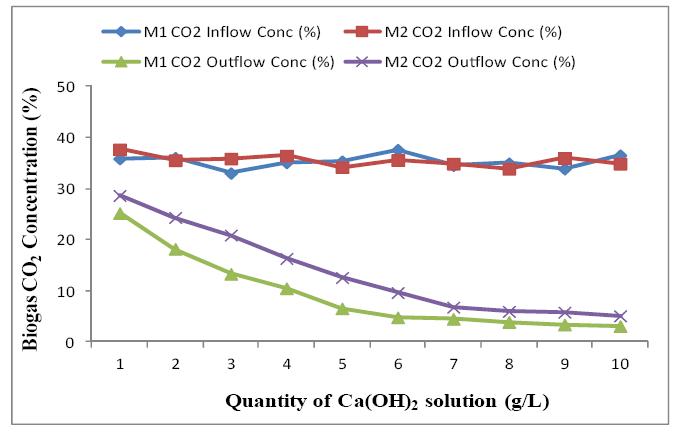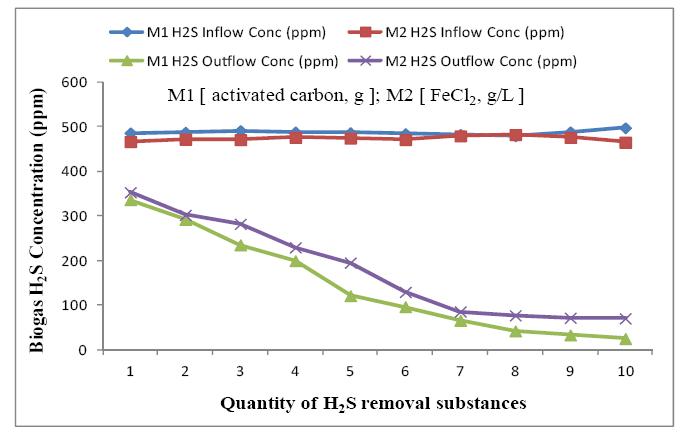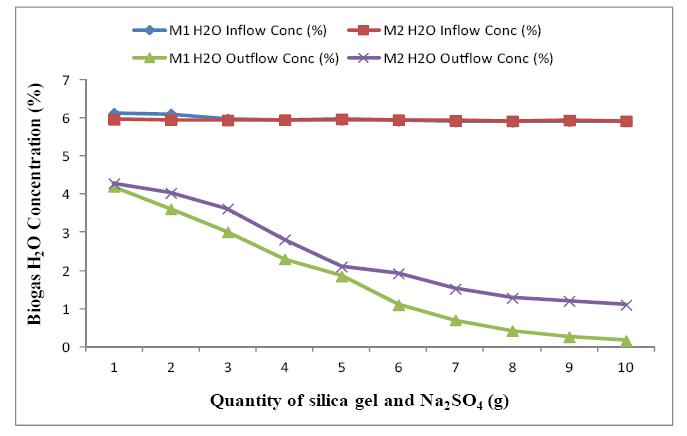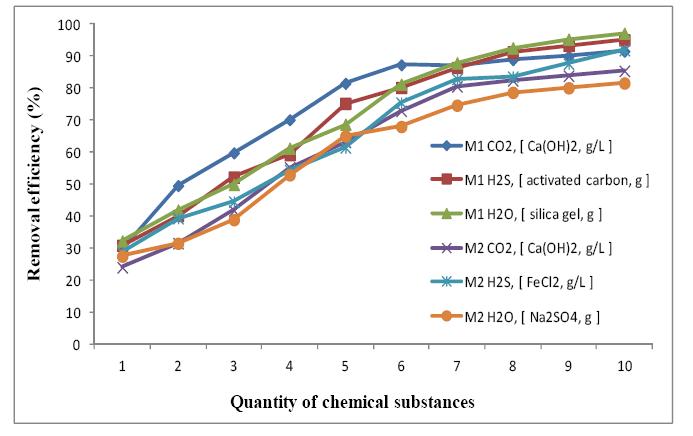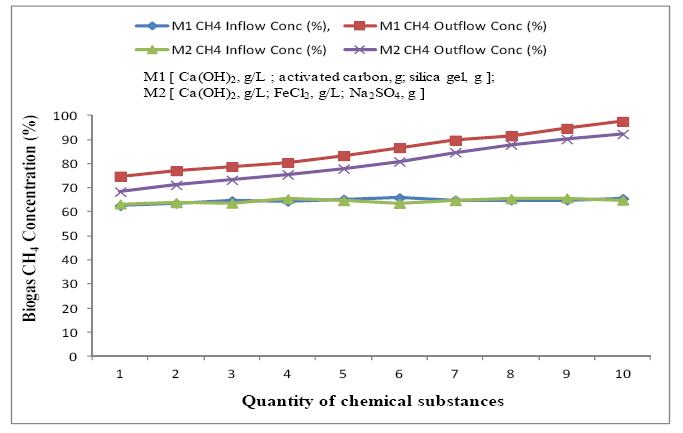1. Introduction
Although world energy demand has continued to increase, but supplies are being dwindled. The present energy systems based on fossil fuel in addition to being limited, change the global climate in many and diverse ways, jeopardize human health and exert massive influences upon biogeochemical cycles. To ensure sufficient energy supply in the future, a transition from fossil fuel-based production towards a sustainable-based production of energy resources is needed. Among the renewable energy sources biogas is a potential transition resource plays an important role as a promising biofuel, which can be generated through an Anaerobic Digestion (AD) of biodegradable material such as biomass, municipal waste, animal waste, and sewage sludge in the absence of oxygen/air [1]. Its versatility helps to use in microturbines, gas engines, and fuel cells for continuous energy production [2,3,4,5]. Biogas is mainly composed of CH4, ranging from 60%-70% by volume and CO2 ranging from 40%-30% along with smaller amounts of other gases and water vapor (H2O, 5-10%): such as oxygen (O2, 0-1%), nitrogen (N2, <1%) and hydrogen sulfide (H2S, 0.005%-2%) [6]. However, as can be seen, such biogas mainly contains methane; other combustible hydrocarbons of biogas do not devote much to the calorific value of gas. Methane enhancement technologies of biogas are obtainable through the development of an upgrading process that aimed it to be utilized effectively to remove contaminant gases. The enhancement technologies of biogas are generally performed two major steps: a cleaning process to remove the trace components which are harmful to the appliances and an upgrading process to adjust the calorific value and relative density in order to meet the standard specifications using as vehicle fuel or for injection in the natural gas grid [6]. Hydrogen sulfide (H2S), one of the major contaminant in biogas, can cause corrosion of energy co-generation parts or other installations, form poisonous sulfur dioxide, and deteriorate engine oil during combustion [7,8,9]. H2S must be cost-efficiently removed in order to increase the practical utilization of biogas. The biogas calorific power is proportional to the CH4 concentration. Therefore, CO2 also be removed if the biogas is to be upgraded to standard natural gas or car fuel since CO2 reduces the energy content of biogas [10]. An untreated or raw biogas usually saturated with water must be eliminated because of the accumulation potential of condensate in the pipeline. As mentioned above, once enhanced its calorific value is 37781.6 kJ/Nm3 and its energy generation capacity is 5 kWh/Nm3. Typical natural gas pipeline specifications require a CO2 content of less than 3% [11] whereas vehicle fuel specifications require a combined CO2/N2 content of 1.5-4.5% in order to avoid significant changes in the vehicle's fuel economy and emission [12]. Therefore, after conversion, Biomethane typically should contain 95-97% CH4 and 1-3% CO2. H2S-concentration of upgrading biogas below 100 ppm, which is well below the maximum concentration of H2S acceptable for running in internal combustion engines [13].
Different methods for biggest cleaning and upgrading are used and comprise the removal of carbon dioxide, the drying of the gas, the removal of trace substances such as hydrogen sulfide, oxygen, ammonia, nitrogen or siloxanes [6]. They differ in functioning, the necessary quality conditions of the incoming gas, efficiency and their operational hindrances. Condensation methods (demisters, or cyclone separators) and drying methods (adsorption or absorption) are used to remove water in combination with foam and dust [6]. CH4 is separated from CO2 using adsorption-based processes, membrane separation, physical or chemical absorption [14,15,16]. After successful separation, the captured carbon dioxide should be finally stored or used in energy production devices such as fuel cells [17,18]. Although carbon dioxide is the major contaminant in the raw biogas during the production of biomethane, it has been shown that the removal of hydrogen sulfide can be of crucial importance for the technological and economic feasibility of the whole gas upgrading process. Among the developed techniques the most important methods are sulfide precipitation, biological scrubbing, chemical-oxidative scrubbing, and adsorption on metal oxides or activated carbon [19]. However, several disadvantages of these methods include selectivity of chemicals used, the high energy requirement for regeneration, stability of the method, waste liquids impact on environmental, large size equipment and high corrosion rate. The major inconvenience of condensation method is atmospheric pressure: dew point minimum 1 °C. To reach lower dew points (minimum −18 °C) the gas has to be compressed before cooling and then expanded to the desired pressure but freezing can occur [20]. In this regard, herein we utilized simple, non toxic chemicals to remove contaminants from biogas generated by anaerobic co-digestion of solid wastes.
The aim of the study is to optimize the upgrading process in terms of low energy consumption and high efficiency, giving high methane content in the upgraded gas. The energy content of biogas is in direct proportion to the methane concentration and by removing contaminant gases through the upgrading process the energy content of the gas is increased. We propose that, the upgraded biogas can be used as a power source for internal combustion engine especially in the farm sector.
2. Materials and Methods
2.1. Anaerobic digestion reactor
A piece of equipment which can turn biodegradable waste into usable fuel energy in the absence of oxygen is known as a bio-digester. A laboratory scale batch digester made of 200 L polypropylene tank (used as a reactor) with an air tight rubber gasket was used for biogas production. The apparatus consists of the disaster area: hopper through which slurry is imported in the digester, inlet pipe which transports slurry from the hopper to the fermentation chamber. There is a 12 mm diameter hose pipe to convey of biogas from the fermentation chamber to raw gas storage chamber. The gas flow is controlled by a gas flow control valve. There also has a bio slurry outlet include collected tank and excess water expelled through the drainage pipe which also controlled by a gate valve.
2.2. Materials preparation
Three organic wastes (Cafeteria Waste (CW), Vegetable Waste (VW) and Fruit Waste (FW)) were collected from the Graduate School of Science and Technology, Kumamoto University and Kokai vegetable market, Kumamoto, Japan. The cow manure (CM) was collected from the cattle farm, Fukuoka, Japan. Then all substrates were crushed into small pieces of 2 mm sizes with mechanical blender except (CM). The blended sample was mixed with equal proportion CW: VW: FW: CM (1:1:1:1) and diluted with tap water in a ratio of 1:1. The prepared feedstock was fed by a volume of 160 L in the biogas digester. The upgrading materials were tested as follows: method 1 (M1) (calcium oxide (CaO), activated carbon and silica gel) and method 2 (M2) (calcium oxide (CaO), Iron (II) chloride (FeCl2) and sodium sulfate (Na2SO4)) to remove CO2, H2S, and H2O from the raw biogas respectively. All purification reagents were derived from Kanto Chemical Co., Ltd, JAPAN. Calcium oxide (CaO) and granular silica gel of size 1-2 mm was crushed manually into powder form to increase the surface area for absorbing CO2 efficiently and water vapor respectively. Herein also used Ca(OH)2 instead of CaO to obtain positive results because unsatisfactory results was investigated due to use of CaO [21]. A concentration of 15% Ca(OH)2 sluury was prepared for each measurement of both methods.
2.3. Experimental apparatus set up
The experiments have been carried out in laboratory scale set-up schematically as shown in Figure 1. The design of experiments consists of four sections: a metabolism section to generate the desired biogas, raw gas sampling, a contaminants removal section to upgrade the biogas and an analysis section. During the study the experiments were operated batch wise with respect to absorption and adsorption phases. The first section (1) is digester as previously described. The second (2) section is raw gas collection chamber and raw biogas sampling, the third (3) section is upgraded and the fourth (4) section is the upgraded biogas storage and sampling. The upgrading section consists of three glass flasks (2 L). The first flask of the upgrading section contains aqueous solutions of CA (OH) 2 was 10 g per liter of water for method 1 and method 2, respectively. The raw gas collecting flask and first upgrading flask was interconnected by 5 mm diameter 0.4 m long hose pipe on the top of the glass tubing pipe. Then 0.3 m long glass tubing was inserted into the raw gas storage flask and the top of the glass tubing outlet port was interconnected with sampling of raw gas bag inlet port by 5 mm diameter 0.4 m long hose pipe. Under batch mode conditions, the raw biogas is introduced by 5 mm diameter 0.3 m long glass tubing at 0.3 mm above from the bottom of the absorber flask as small bubbles through the Ca(OH)2 solution to absorb CO2 in both methods.
For method 1, the first, second and third flask of upgrading section was linked-up by 5 mm diameter and 1 m long U-shaped hose pipe respectively. Removal of H2S and H2O the first and second interconnected hose pipe was filled with activated carbon and then second and third interconnected hose pipe was filled with silica gel respectively. In method 2, first and second flask of upgrading section was interconnected by 5 mm diameter 0.4 m long hose pipe on the top of the glass tubing pipe and it was closed during the study period for method 1. The biogas enters the H2S removal unit after passing the CO2 removal unit by 5 mm diameter 0.3 m long glass tubing at 0.3 mm above from the bottom of the absorber flask as small bubbles through the FeCl2 solution to remove H2S.
Similarly the second and third flask interconnected U-shaped hose pipe was filled with Na2SO4 for removal of H2O in method 2. The biogas enters the moisture removal unit after passing the FeCl2 solution to ensure to dry the gas for method 2.
When gas was transferred from CO2 removal flask to H2S removal flask, the first and second flask U-shaped interconnected line was closed through the gas flow control valve during the experiments since FeCl2 solution was used for method 2 and vice versa due to dry activated carbon was used for method 1 means the first and second flask of upgrading section interconnected glass tubing line was closed which is used for method 2. As silica gel, Na2SO4 and activated carbon materials have significant water and H2S absorbing capability. Therefore, gas flows through the silica gel, Na2SO4 and activated carbon adsorbents from the one end to the other end of the U-shaped hose pipe. In this regard, both ends of the U-shaped hose pipes were attached by cotton to increases absorbing capacity. Finally, upgraded methane rich biogas was accumulated in the third flask with H2S, CO2, and H2O being stripped off from the biogas stream. Then upgraded gas was transferred from the third flask to the aluminum gas storage bag (GL Science Inc., Japan) for sampling gas compositions. All the flasks and their ports were closed with air tight rubber stopper. Biogas samples were collected before and after it flowed through these substances and CH4 enriched as well as the removal efficiency was investigated as the percentage of CO2, H2S, and H2O removed from the bags of each sample. The tests were conducted with a flow rate of biogas at 1.5 L/min. The design consideration was that there were to be no energy requirements for the system operation.
2.4. Analytical methods
Gas composition was analyzed off line by gas chromatography (GC-8AIT/C159 R8A SHIMADZU Corporation, JAPAN) and Testo-350 portable gas analyzer (Testo AG., Germany). The gas chromatograph was fitted with a Porapak N 80/100, 274.32 cm, 1/8 mesh 250× 250 × 145 mm column, a molecular sieve (Mole sieve 5 A 60/80, 182.88 cm, 1/8), maximum temperature 399 °C, temperature stability ±0.1 °C a stainless-steel column and a thermal conductivity detector. Detector type was TCD made by Tungsten rhenium filament. Maximum temperature and sensitivity of the detector was 400 °C and 7000 mVmL/mg respectively. Argon (Ar) was used as the carrier gas at a flow rate of 30 mL/min. The column temperature was 60 ℃ and the injector/detector temperature was 80 ℃ and current 60 mA. Methane, CO2, H2S, and H2O content of raw biogas and upgraded biogas were compared. The rate of gas flow, pressure, pH, water content was measured using gas flow meter, gas pressure gauge, digital pH meter (HM-25R) and moisture meter (MOC63u), respectively.
3. Results and Discussion
3.1. Absorption of CO2
The study was aimed at fabricating a biogas to optimize the calorific value as well as a cleaning system of biogas derived from solid wastes. The biogas was passed through the upgrading first flask where it reacted with Ca(OH)2 solution. In this case, aqueous solutions of Ca(OH)2 were used as chemical solvents to demonstrate the ability to absorb CO2. The reactor flask was observed to remove a high proportion of CO2 gradually (approximately 85-90% removal efficiency), resulting in CH4 enriched bogus. However, it was a mass dependent process. These gaseous concentrations were found to decrease mass to remove the substances. This alkali solution guaranteed CO2 reaction in the biogas intensively through an acid-base neutralization reaction absorbing and reducing the desired gas. The moles in this strong base solution were in excess in comparison to those in the gas and therefore CO2 was dissolved. These CO2 absorption reactions take place as shown in equations 1, 2 and 3:
| CO2(g) + H2O(1) → H2CO(aq) |
(1)
|
| CaO(s) + H2CO3(aq) → CaCO3(s) + H2O(1) |
(2)
|
| Ca(OH)2(aq) + H2CO3(aq) → CaCO3(s) + H2O(1) |
(1)
|
Figure 2 represents the variations in CO2-concentration before and after treating by Ca(OH)2 solution. In the both methods the average CO2-concentration in the raw biogas was about 35.4%, whereas, the CO2-concentration in upgrading gas decreased steadily with increasing of Ca(OH)2 concentration. In method-1, the CO2-concentration is the minimum 3.1% when the concentration of Ca(OH)2 was 10 g/L. In this method, some CO2 simultaneously absorbed and reversibly bound on the surface of activated carbon and silica gel before come out from the reactor. By contrast, in method-2, the CO2-concentration is the minimum 5.1% of Ca(OH)2 was 10 g/L. The CO2-concentration decreased sharply in method 1 more than method 2, up to 7 g/L of Ca(OH)2 solution. These results showed that there has no significant difference between two methods. However, it can be seen that the concentration almost remained stable at 7 g/L to 10 g/L in both methods. These absorption processes also influenced by agitation, turbulence in the gas-liquid phase contact time and solution concentration [21].
3.2. Removal of H2S
This investigation evaluated a sulfide removal process based on the selected activated carbon and FeCl2 was tested along with variable mass of H2S removing phases in the biogas stream. Previously, FeCl2 was used successfully to control H2S levels in the sludge digesters at municipal wastewater treatment plants. However, the purpose of our tests was to compare the effectiveness of the FeCl2 solution and activated carbon with varied concentration to remove H2S from the generated raw biogas stream as shown in Figure 3. All tests were conducted with the controlled flow rate of bugs directly from the digester.
Based on the substrates the average H2S-concentration introduced was 486 ppm and 472 ppm through the activated carbon and FeCl2 solvent, after passing these concentrations decreased steadily with respect to amount of these chemicals by 24 ppm and 69 ppm at 10 g and 10 g/L in method 1 and method 2, respectively. We observed that removal trends gradually decreased and was remained almost stable at 8 to 10 g and 7 to 10 g/L for method 1 and method 2, respectively. So, at 10 g of activated carbon and 10 g/L of FeCl2 might be the optimum condition for this study and then experiment was stopped. The possible reason is that commonly two chemical reactions used for dissolved iron compounds and H2S. Iron(II) chloride reacts with the H2S present in the biogas to form FeS as solid precipitated particles. These are the chemical reactions as shown in equations 4, 5 and 6:
| FeCl2 + H2S → FeS↓ + 2HCl |
(4)
|
| 2Fe3+ + 3S2− 2FeS + S |
(5)
|
Due to the precipitation of FeS, the presence of H2S in the biogas is removed and therefore this method is very efficient in reducing high concentrations of H2S. In this study, can be achieved the H2S concentration is lowered to the permitted limit of standard in biogas for running in internal combustion engines [13].
3.3. Removal of H2O from untreated biogas
Water vapor is the leading corrosion risk factor when react with H2S produces deterioration H2SO4 acid. It is absorbed and reversibly bound to the surface of drying agents like silica gel and sodium sulfate. The color of the silica gel was changed from blue to pink after absorbing the water vapor from the raw biogas. Figure 4 shows the comparisons profile of method 1 and method 2 for removing H2O-concentration of biogas based on inflow and outflow concentration employed by silica gel and sodium sulfate respectively. The result shows that the average H2O-concentration introduced was 5.9% in method 1 and method 2. A steady fall in H2O-concentration was noticed from 1 to 5 g and 1 to 6 g of sodium sulfate and silica gel, respectively. Although the water, decreasing percentages less from 6 to 10 g than 1 to 5 g in both methods.
However, the H2O-concentration decreased after upgrading of the biggest was 4.24% and 0.16% for treating with 1 and 10 g silica gel. By contrast, the H2O-concentration was decreased 4.28% and 1.1% after upgrading of the gas stream with 1 and 10 g sodium sulfate. The results indicated that the silica gel has a better water removal efficiency than sodium sulfate. The possible reason is that silica gel is extremely porous and can absorb a large amount of water due to its large internal surface area. On the other hand, due to the hard granular form of Na2SO4 has low extraction capability of water. However, the results of these studies showed that silica gel and Na2SO4 effectively removed the water from the gas stream. We also observed that the H2O-concentration was at its lowest level of 10 g and remained stable at about 8 to 10 g in both methods. The silica gel can be reactivated after saturation by heating it in an oven at 150 °C for 3 hours to remove the adsorbed H2O.
3.4. Comparative results study of removal efficiency
Figure 5 shows the comparative contaminant removal efficiencies with respect to chemical substances of method 1 and 2. Of all the materials the removal efficiency was increased almost linearly with increases the mass of chemical agents. The removal efficiency was the highest in method 1, with efficiency results such as 91.5%, 97.1% and 91.8%, for CO2, H2S, and H2O, respectively during the experiments. The corresponding CH4 enrichment was 97.5%. It is observed that the removal efficiency was fluctuated depending on its inflow concentrations. However, the removal efficiency, increased dramatically at 1 g to 6 g, and then increasing tendency little bit decreased.
The comparative removal efficiency presented in Figure 5 is significant. It is expected that chemical reaction would considered as the best way to upgrade biogas by enhancing CH4-concentration. Finally, these results indicated that the method 1 is good enough compare to method 2. It also describes that adsorbing efficiencies depend on the degree of saturation of the adsorbent and on the ratio of the gas flow and the mass of adsorbing substance. The H2S removal efficiency of activated carbon was higher than FeCl2. Because of activated carbon is a form of carbon that has been processed to make it extremely porous and thus to have a very large surface area available for adsorption or chemical reactions [22]. It shows affinity to polar substances such as H2O, CO2, SO2 among others. In this case of H2S, activated carbon adsorbs and decomposes it to elemental sulfur.
3.5. Comparative upgraded of CH4-concentration
Figure 6 shows that the comparison CH4-concentration enrichment trend of raw gas to upgrade gas is depicted for method 1 and method 2. The result shows that the relative concentration of CH4 upgraded with proportional to the increasing concentration of chemical substances in both methods. In this study, we observed that between 1 to 10 g there was a steady increased in CH4-concentration. The average inflow CH4-concentration was about 64.5% for method 1 and method 2. The concentration of CH4 increased at treating biogas was 74.7% and 97.5% at 1 g and 10 g and/or 1 g/L and 10 g/L in method 1. The enriched CH4-concentration is the permitted of standard gas grid level. While in method 2, the CH4-concentration increased was 68.3% to 92.2% at 1 g to 10 g and/or 1 g/L and 10 g/L. The highest percentage of methane 97.5% were possible to avail by using 10 g of chemical substances in method 1 due to CO2 and H2S is removed simultaneously by activated carbon. The results indicate that for CH4/ CO2/ H2S/ H2O mixtures, the best separation in the feed gas was achieved in method 1.
4. Conclusions
Combined upgrading chemical method could offer a viable alternative for methane enrichment in bogus, since all contaminants capture occurs in the same process. The results showed that the CH4-concentration is improved by reducing the CO2, H2S and H2O content of the bogus to a considerably lower concentration with the removal chemical substances. The removal efficiency was the highest in method 1 and method 2, with efficiency results such as 91.5%, 95.0%, and 97.1% and 85.3%, 91.8%, and 81.5%, of CO2, H2S and H2O respectively, with a corresponding CH4 enrichment of 97.5% and 92.2%, can be achieved in comparison to the initial average CH4-concentration of 64.5%. Thus, combined method was used successfully resulting in upgrading CH4-concentration. We propose that the upgraded method can successfully be integrated with the digester plant in farm sectors as it is simple to operate and the materials required are readily available.
Acknowledgments
The first author would like to acknowledge the Ministry of Education, Culture, Sports, Science and Technology (MONBUKAGAKUSHO: MEXT) for providing the financial support (PhD scholarship) for this research and the extended help of Thermal engineering laboratory under the Department of Mechanical System Engineering, Kumamoto University, Japan, for providing the facilities of experimentation. We thank our biomass group lab fellows for helping with the measurements.
Conflict of Interest
All authors declare no conflicts of interest in this paper.









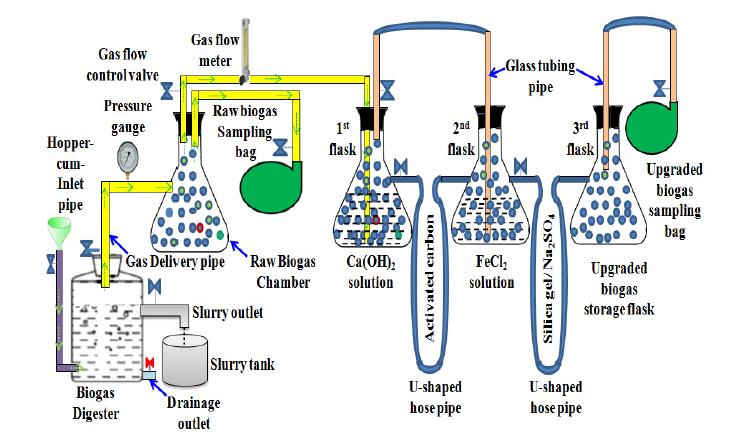
 DownLoad:
DownLoad: 